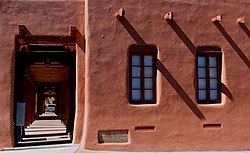Adobe

Adobe is a building material made from soil and often organic matter.[1] Adobe means mudbrick in Spanish.[2] It can also mean any kind of earth construction.
Adobe is one of the earliest building materials ever used.[3] It is found all over the world. The techniques used in adobe construction have not changed since the 16th century in the Southwestern United States.[3] Because they are not fired in a kiln they never become hard.[3] They shrink and swell as the water content in them changes.[3] Also, as they get wetter, they become weaker.[3]
Adobe does not permanently stick to wood, metal or stone because it moves more than they do.[3] This causes cracks and seperation from other materials.[3] Stone is sometimes used as a foundation and wood for the roof.[3] These are usually held in place by their own weight or the weight of the adobe pressing down on them.[3] But adobe construction is cheap and the materials are usually easy to find.
Adobe Media
Adobe wall (detail) in Bahillo, Palencia, Spain
Renewal of the surface coating of an adobe wall in Chamisal, New Mexico
Adobe walls separate urban gardens in Shiraz, Iran
Church at San Pedro de Atacama, Chile
Adobe style in Santa Fe, New Mexico
The Great Mosque of Djenné, Mali, is built in adobe. The struts projecting from the wall serve as decoration, as well as supports for scaffolding during maintenance.
Cliff dwellings of poured or puddled adobe (cob) at Cuarenta Casas in Mexico
Adobe bricks near a construction site in Milyanfan, Kyrgyzstan
The earthen plaster removed, exposing the adobe bricks at Fort St. Sebastien in France
References
- ↑ "Solid Earth Adobe Buildings". SolidEarth.co.nz. Retrieved January 8, 2017.
- ↑ "adobe". Meram-Webster Dictionaries. Merriam-Webster, Incorporated. Retrieved January 8, 2017.
- ↑ 3.0 3.1 3.2 3.3 3.4 3.5 3.6 3.7 3.8 "Preservation of Historic Adobe Buildings". Technical Preservation Services. National Park Service, U.S. Department of the Interior. Retrieved January 8, 2017.









